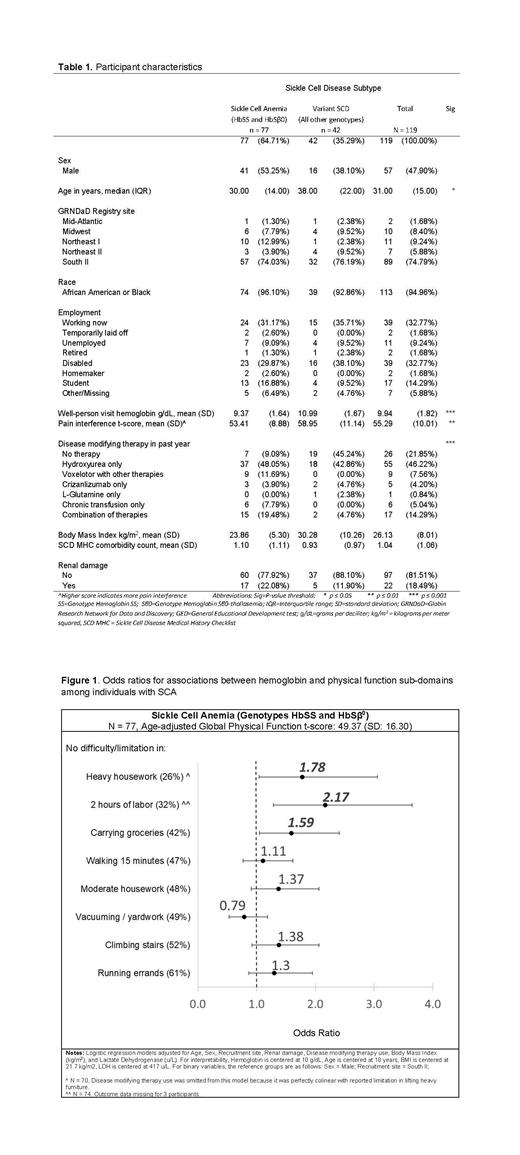Introduction
People living with sickle cell disease (SCD) need high levels of physical function to support independent living. Researchers should prioritize identifying modifiable targets that improve physical function. People with SCD who have physical limitations and low muscular capacity are at risk of poor function and lower quality of life. This abstract describes domain-specific and global self-reported physical function among adults living with SCD and identifies cross-sectional associations between hemoglobin and physical function.
Methods
Respondents consented to chart abstraction and completed the PROMIS Physical Function Short Form 8b survey. We operationalized domain-specific function as binary variables indicating no impairment versus any impairment in 8 activities. We calculated participants' global physical function using PROMIS' HealthMeasures web tool calibrated to the US population and converted to t-scores (range: 20.3 [worst] to 60.1 [best]).
Eligible participants met the following criteria: age 18+ when surveyed,labs drawn during a non-acute encounter within +/- 30 days of the survey, no pregnancy-related outcome the year before survey, no history of bone marrow transplant, and available covariate data. We estimated cross-sectional associations between hemoglobin and 8 physical function sub-domains using multivariable logistic regression. We fit heteroscedastic tobit regressions to estimate the association between hemoglobin and global physical function. We adjusted the models for age, sex, recruitment site, history of renal damage, disease-modifying therapy (DMT) use, body mass index, and lactate dehydrogenase (LDH). We used STATA/SE 18.0 to perform the analyses separately by SCD subtype: sickle cell anemia (SCA) - HbSS/HbSβ 0, versus other subtypes (variant SCD).
Results
Between 2016 and 2023, 331 people with SCD at 7 GRNDaD sites completed the survey; 119 adults met eligibility criteria (52% female). The median age was 31 years (IQR: 24 , 39 years); 95% identified as Black, and 65% had SCA [Table 1]. Seventeen percent reported no limitation in any domain. Those with While
For those with SCA, the hardest activity was heavy housework (74% reported limitation), while the easiest was running errands (39% reported limitation). For those with variant SCD, the hardest activity was heavy housework (88% reported limitation), while the easiest was climbing stairs (64% reported limitation). In adjusted logistic regression models among those with SCA, higher steady state hemoglobin was associated with higher odds of full function when carrying groceries (OR = 1.59, 95% CI = 1.05 , 2.41), performing 2 hours of labor (OR = 2.17, 95% CI = 1.29 , 3.65), and heavy housework (OR = 1.78, 95% CI = 1.04 , 3.06) [Figure 1]. Hemoglobin was not associated with any function sub-domains for individuals with variant SCD. In adjusted tobit regression models, hemoglobin was not associated with global physical function for those with SCA (β= 0.23 95% CI = -0.99 , 1.45) nor with variant SCD (β= -0.10, 95% CI= -0.77 , 0.58).
Conclusions
People with SCA reported better age-adjusted subjective function than those with variant disease, perhaps reflecting availability of treatments for SCA. In SCA, hemoglobin was positively associated with higher function in the 3 PROMIS sub-domains that respondents ranked as most challenging. Hemoglobin was not associated with global physical function for either SCD subtype. research in larger longitudinal samples is needed to explicate potential mechanisms linking hemoglobin to self-reported function sub-domains, corroborate the observed patterns of self-reported function by subtype, investigate associations between hemoglobin and objectively measured physical function, and identify how within-person changes in hemoglobin may contribute to changes in performing challenging everyday physical function activities.
Disclosures
Kanter:Novartis: Consultancy, Honoraria, Membership on an entity's Board of Directors or advisory committees; Vertex: Consultancy, Honoraria; Bluebird Bio: Consultancy; Beam: Consultancy, Honoraria; Guidepoint Global: Consultancy; Bausch: Honoraria; Chiesi: Honoraria, Membership on an entity's Board of Directors or advisory committees; Austin Therapeutics: Honoraria, Membership on an entity's Board of Directors or advisory committees; Watkins, Lourie, Roll&Chance: Consultancy; Fulcrum: Consultancy; ECOR1: Consultancy. Manwani:Novartis, Pfizer, Novo Nordisk, Editas, GBT: Consultancy. Little:Hemex: Patents & Royalties: Make no profit; NHLBI: Honoraria; Novo Nordisk: Consultancy; bluebird bio: Consultancy; GBT: Research Funding; USC: Research Funding; NASCC: Research Funding; Biochip Labs: Patents & Royalties: Make no profit; FORMA: Other: Adjudication committee for Hibiscus study; Pfizer: Consultancy; American Society of Hematology: Research Funding. Lanzkron:Pfizer: Consultancy; Teva Pharmaceutical Industries: Current equity holder in publicly-traded company; CSL-Behring: Research Funding; HRSA: Research Funding; Global Blood Therapeutics: Research Funding; National Alliance for Sickle Cell Centers: Other: Vice president ; PCORI: Research Funding; Novo Nordisk: Consultancy; Magenta: Consultancy; Takeda: Research Funding; Novartis: Consultancy, Research Funding; Bluebird Bio: Consultancy; Imara/Enliven Therapeutics: Research Funding.


This feature is available to Subscribers Only
Sign In or Create an Account Close Modal